Home / Electrophilic Aromatic Substitutions (1) – Halogenation of Benzene
Reactions of Aromatic Molecules
Electrophilic Aromatic Substitutions (1) – Halogenation of Benzene
Last updated: April 16th, 2025 |
Halogenation of Benzene via Electrophilic Aromatic Substitution
- Unlike alkenes, benzene does not undergo rapid chlorination or bromination with Cl2 or Br2
- When it does undergo reaction with halogens, it occurs via substitution instead of addition; a C-H bond on the aromatic ring breaks, and a C-X bond forms (where X is a halogen).
- This occurs via electrophilic aromatic substitution, with the rate limiting step being attack on the halogen electrophile by the aromatic ring. This generates a carbocation intermediate, which is quickly deprotonated to re-generate the aromatic ring.
- Halogenation can be made much more rapid by using a Lewis acid such as AlCl3 or FeCl3. This accepts a lone pair from the halogen, making the halogen an even better electrophile.
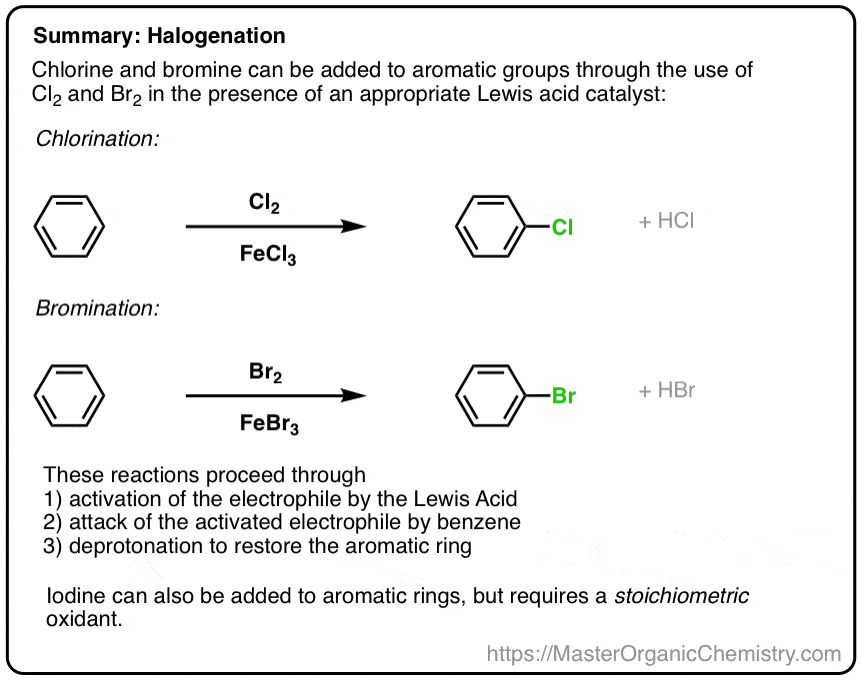
[What about fluorine? If F2 wasn’t such a ravenous beast, we’d include it too, but as it stands, fluorine is best introduced to aromatic rings indirectly]
Table of Contents
- Halogenation of Benzene via Electrophilic Aromatic Substitution
- Lewis Acids Can Be Used To “Activate” Electrophiles
- Electrophilic Chlorination of Benzene
- Electrophilic Bromination of Benzene
- Electrophilic Iodination of Benzene
- Summary: Halogenation of Benzene
- Notes
- Quiz Yourself!
- (Advanced) References and Further Reading
1. Halogenation of Benzene via Electrophilic Aromatic Substitution
Now that we’ve spent ample time digging into
- the mechanism of electrophilic aromatic substitution,
- activating and deactivating groups, and
- ortho- ,para– and meta– directors,
we’re finally ready to dig into some specific reactions in detail. First up: halogenation. How do we install Cl, Br, or I on an aromatic ring?
You may recall that alkenes react readily with Cl2, Br2, and I2 to form dihalides.
Benzene? Not so much. And when it does react with aromatic rings, it provides substitution rather than addition products.
[Why? Recall that the resonance energy of benzene is about 36 kcal/mol, and electrophilic aromatic substitution disrupts aromaticity. ]
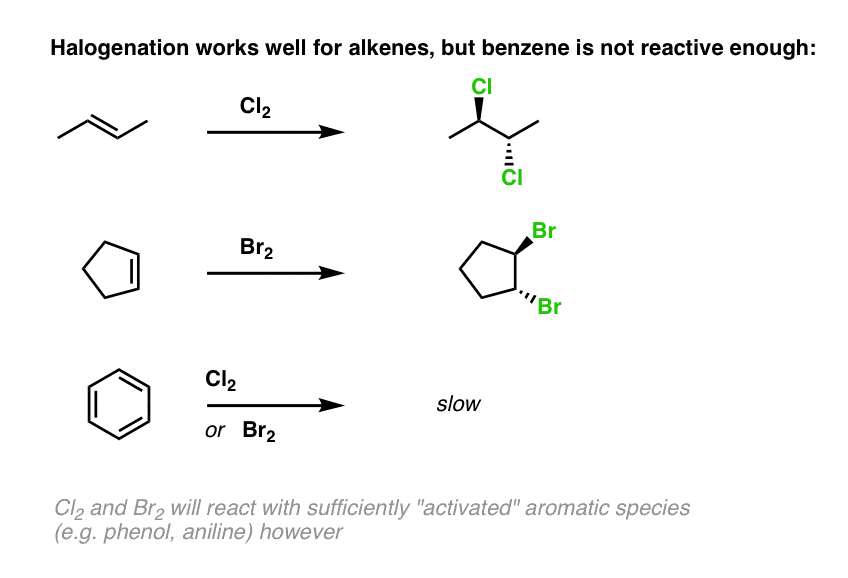
2. Lewis Acids Can Be Used To “Activate” Electrophiles
Chlorine itself will react with “activated” benzene derivatives (such as phenol and aniline) but in order for chlorination to occur with electron-neutral or electron-poor aromatics, it needs a kick in the pants.
This “kick in the pants” is provided by a Lewis acid. FeCl3 or AlCl3 are the industry standard, but in practice many different Lewis acids can be employed.
You may recall from the chapter on alcohols that protic acids are commonly used to turn poor electrophiles (e.g. alcohols) into better electrophiles by converting an alcohol into its conjugate acid. [See article: What Makes a Good Leaving Group?].
The “activated” alcohol is then able to participate in nucleophilic substitution or elimination reactions that it would not have been able to participate in otherwise:
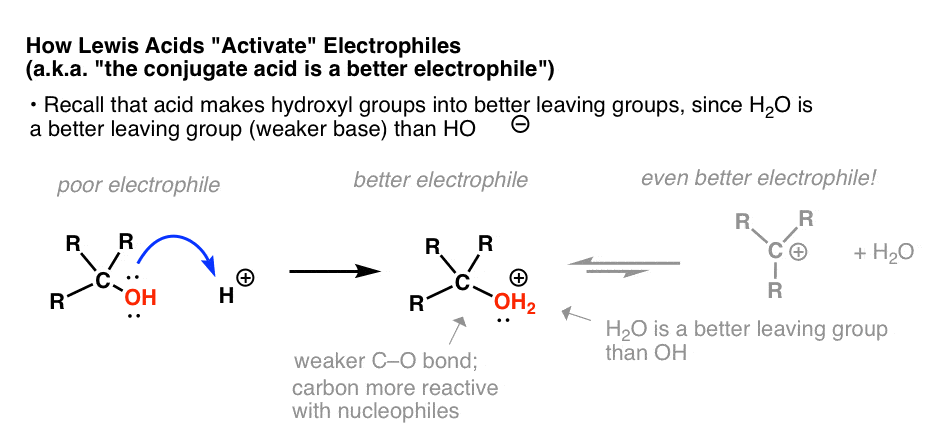
[The leaving group may even depart entirely to give a carbocation, an even better electrophile!]
In much the same way, coordination of the Lewis acid to one of the chlorines converts it into an even better leaving group, with the net effect of weakening the Cl-Cl bond. Attack on the terminal Cl by a nucleophile results in the loss of [Cl-FeCl3]– , an even better leaving group than Cl– .

Sometimes we draw this as an equilibrium. Textbooks vary. I personally prefer showing the intact Cl–Cl bond.

3. Electrophilic Chlorination of Benzene
This “activated” electrophile can then be attacked by the nucleophile (the benzene ring) in an electrophilic aromatic substitution reaction. Here, C-Cl forms, and the C-C (pi) bond breaks!
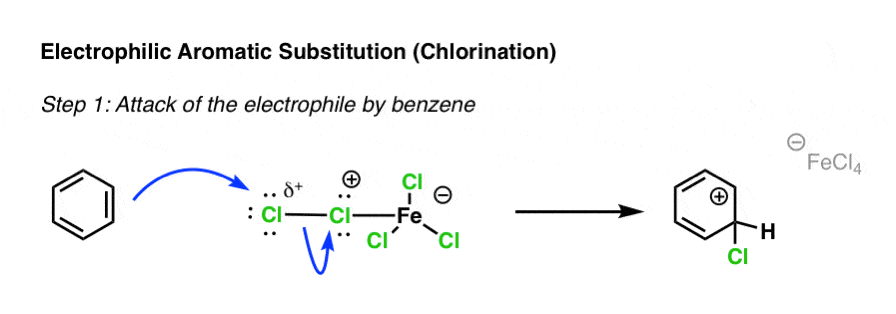
In the next step, a weak base removes a proton from the carbocation intermediate, breaking C-H and forming C-C (pi).
If this looks a tiny bit familiar, that’s because this second step greatly resembles the second step in the E1 reaction. As in the E1, only a very weak base is required to remove a proton adjacent to a carbocation. The chloride ion (Cl– ) will do.

[Note: there are a lot of different ways to draw this, I’ve only shown one. See Note 1].
The final product here is chlorobenzene plus one equivalent of HCl. The FeCl3 is then free to react with another equivalent of Cl2 . In other words, it behaves as a catalyst in this reaction.
4. Electrophilic Bromination of Benzene
The same set of principles operate for electrophilic bromination. Here, the Lewis acids used are often FeBr3 or AlBr3. [Why not FeCl3 or AlCl3? Note 2]
The first step is activation of Br2, followed by attack and deprotonation, as before:

It’s essentially the same reaction as chlorination except with the halogens swapped out.
5. Electrophilic Iodination of Benzene
It’s also possible to iodinate benzene using I2 , but the activation step is different. Here, however, it turns out that a Lewis acid catalyst is not sufficient to make iodine an active enough electrophile to react with most aromatic rings.
Instead, a stoichiometric amount of an oxidant is used to convert I2 to I+ . A common example cited is HNO3, which in the presence of additional acid (e.g. H2SO4) is a source of the very active oxidant [NO2]+ which converts I2 to I+ . [Note 3]

Once formed, the benzene ring then reacts with I+ in the two-step electrophilic aromatic substitution mechanism to give the new carbon-iodine bond.
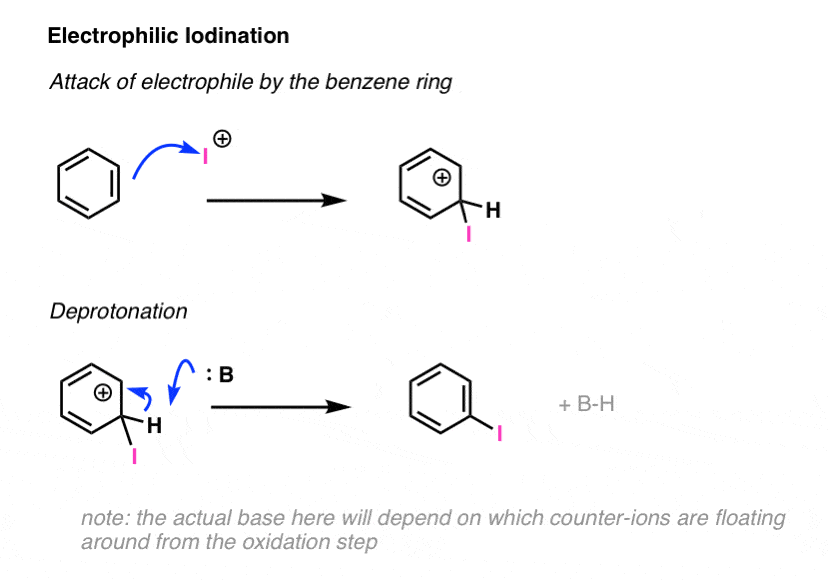
The exact identity of “B” will depend on the oxidant used to convert I2 into I+ . A single equivalent of water will do the trick, for example.
6. Summary: Halogenation of Benzene
In the cases of chlorine, bromine, and iodine, electrophilic aromatic substitution follows three steps.
- Activation of the electrophile by a Lewis acid catalyst (or stoichiometric oxidant, in the case of iodine)
- Attack of the activated electrophile by the aromatic ring.
- Deprotonation to regenerate the aromatic ring.
In the next post we’ll cover two more important electrophilic aromatic substitution reactions: sulfonation and nitration, and they will also follow this three-step pattern!
Notes
Related Articles
- Electrophilic Aromatic Substitutions (1) – Halogenation of Benzene
- Electrophilic Aromatic Substitution: Introduction
- Electrophilic Aromatic Substitution – The Mechanism
- Electrophilic Aromatic Substitutions (2) – Nitration and Sulfonation
- EAS Reactions (3) – Friedel-Crafts Acylation and Friedel-Crafts Alkylation
- Electrophilic Aromatic Substitution Practice Problems (MOC Membership)
Note 1. There are a few different ways one could depict this; the drawing above shows the pair of electrons in the Fe-Cl bond acting as the base, which is essentially the same as dissociation of Cl- from FeCl4(-) followed by it acting as a base. One could also draw a lone pair from the Cl of FeCl4 acting as a base, giving H-Cl-FeCl3, followed by breakage of the Fe-Cl bond to give FeCl3 and HCl.
Note 2. It’s not that FeCl3 or AlCl3 aren’t strong enough to do the job here; the problem is that using Br2 in the presence of FeCl3 will lead to some scrambling of the halogens, resulting in a small amount of chlorination products. Using the bromide salts eliminates this problem.
Note 3. Many other oxidants have found use in this reaction. Another is copper (II) bromide (CuBr2).
Quiz Yourself!

Become a MOC member to see the clickable quiz with answers on the back.

Become a MOC member to see the clickable quiz with answers on the back.
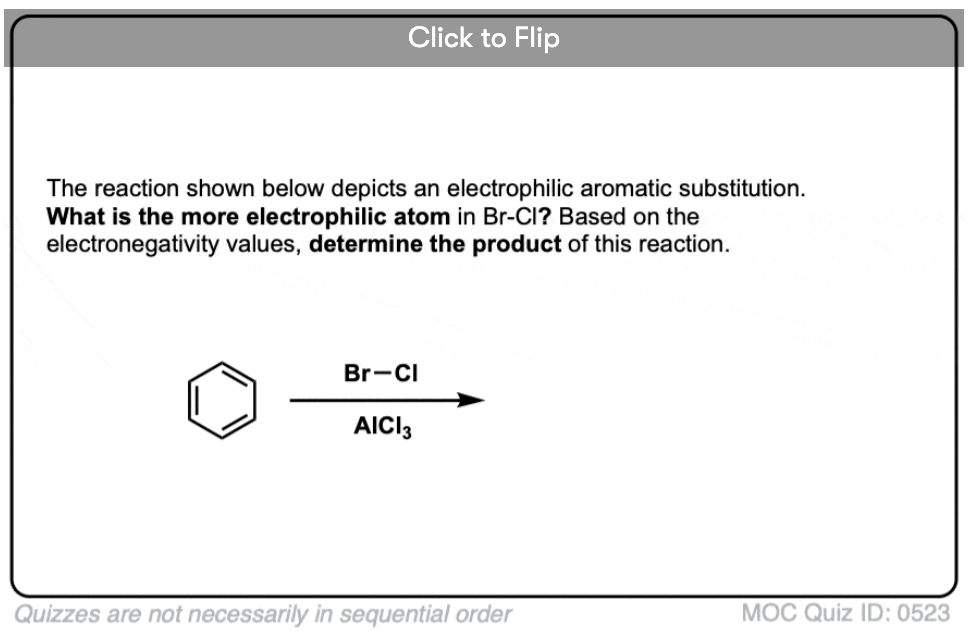
Become a MOC member to see the clickable quiz with answers on the back.

Become a MOC member to see the clickable quiz with answers on the back.
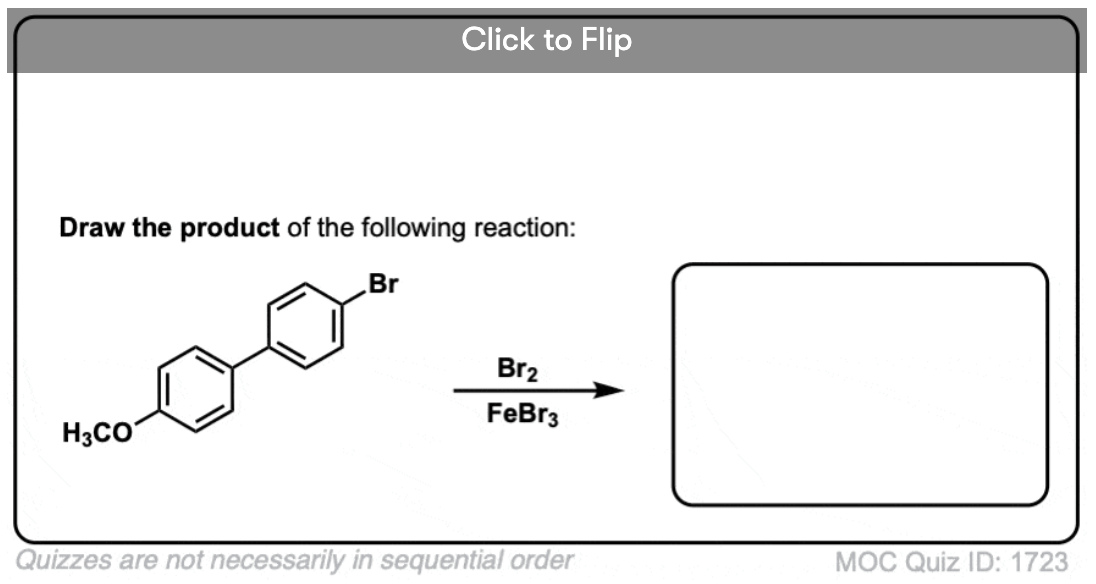
Become a MOC member to see the clickable quiz with answers on the back.

Become a MOC member to see the clickable quiz with answers on the back.
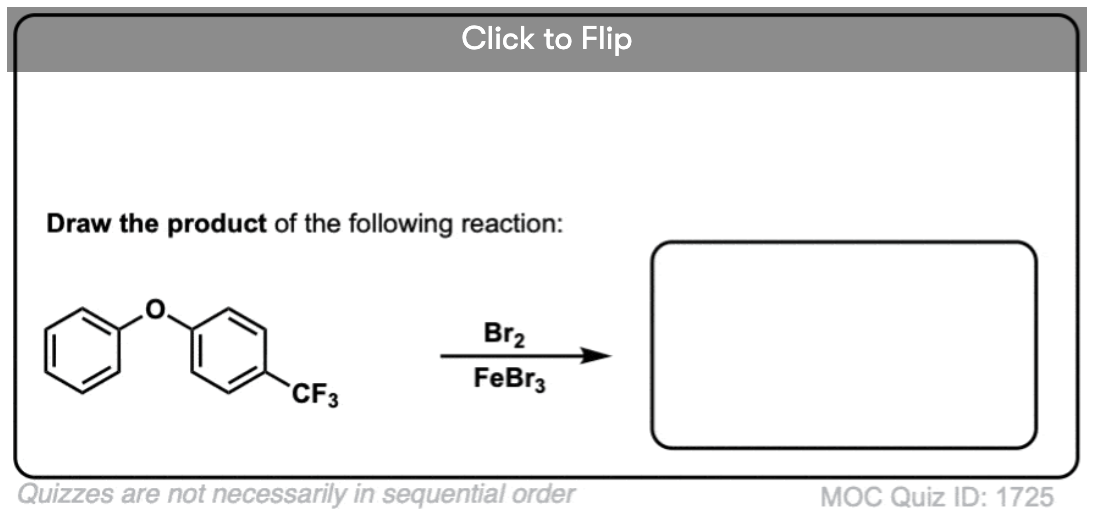
Become a MOC member to see the clickable quiz with answers on the back.
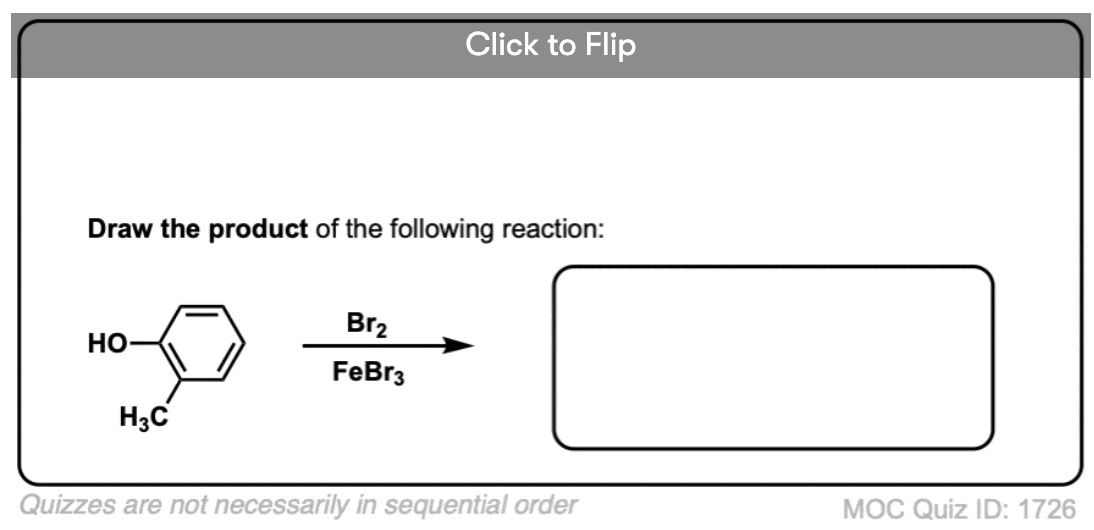
Become a MOC member to see the clickable quiz with answers on the back.

Become a MOC member to see the clickable quiz with answers on the back.
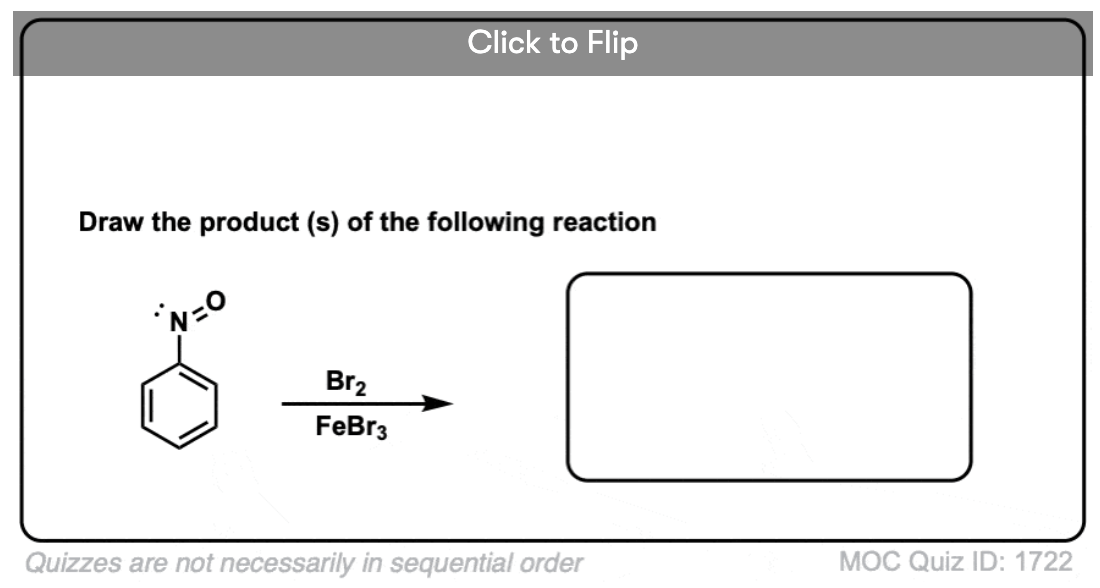
Become a MOC member to see the clickable quiz with answers on the back.
(Advanced) References and Further Reading
For more detailed references on the individual halogenation reactions (chlorination, bromination, iodination), consult the sections in the reaction guide. The references here are highlights.
Electrophilic aromatic fluorination is possible, and the last two papers describe that.
Electrophilic aromatic chlorination:
- The kinetics of aromatic halogen substitution. Part IV. The 1-halogenonaphthalenes and related compounds
P. B. D. de la Mare and P. W. Robertson
J. Chem. Soc., 1948, 100-106
DOI: 10.1039/JR9480000100
An early paper studying the kinetic of electrophilic aromatic halogenation. - Aromatic Substitution. XVII. Ferric Chloride and Aluminum Chloride Catalyzed Chlorination of Benzene, Alkylbenzenes, and Halobenzenes
George A. Olah, Stephen J. Kuhn, and Barbara A. Hardie
Journal of the American Chemical Society 1964, 86 (6), 1055-1060
DOI: 10.1021/ja01060a017 - Rates of Chlorination of Benzene, Toluene and the Xylenes. Partial Rate Factors for the Chlorination Reaction
Herbert C. Brown and Leon M. Stock
Journal of the American Chemical Society 1957, 79 (19), 5175-5179
DOI: 1021/ja01576a025Electrophilic aromatic Bromination: - Relative Rates of Bromination of Benzene and the Methylbenzenes. Partial Rate Factors for the Bromination Reaction
Herbert C. Brown and Leon M. Stock
Journal of the American Chemical Society 1957, 79 (6), 1421-1425
DOI: 1021/ja01563a040 - Aromatic Substitution. XIV. Ferric Chloride Catalyzed Bromination of Benzene and Alkylbenzenes with Bromine in Nitromethane Solution
George A. Olah, Stephen J. Kuhn, Sylvia H. Flood and Barbara A. Hardie
Journal of the American Chemical Society 1964, 86 (6), 1039-1044
DOI: 10.1021/ja01060a014 - Aromatic Substitution. XV. Ferric Chloride Catalyzed Bromination of Halobenzenes in Nitromethane Solution
George A. Olah, Stephen J. Kuhn, Sylvia H. Flood, and Barbara A. Hardie
Journal of the American Chemical Society 1964, 86 (6), 1044-1046
DOI: 1021/ja01060a015Electrophilic aromatic iodination: - Halogenation with copper(II) halides. Synthesis of aryl iodides
William C. Baird and John H. Surridge
The Journal of Organic Chemistry 1970, 35 (10), 3436-3442
DOI: 10.1021/jo00835a055
A simple and straightforward method for synthesizing monoiodoarenes using CuI2 as the iodinating agent. - Electrophilic Fluorination of Aromatics with Selectfluor™ and Trifluoromethanesulfonic Acid
Tatyana Shamma, Herwig Buchholz, G.K. Surya Prakash, and George A. Olah
Israel J. Chem. 1999, 39 (2), 207-210
DOI: 1002/ijch.199900026
This paper describes the use of Selectfluor™ as a reagent for electrophilic aromatic fluorination. Selectfluor is a commercially available, easily-handled solid, and a convenient source of “F+” due to the N-F bond. - Palladium-catalysed electrophilic aromatic C–H fluorination
Kumiko Yamamoto, Jiakun Li, Jeffrey A. O. Garber, Julian D. Rolfes, Gregory B. Boursalian, Jannik C. Borghs, Christophe Genicot, Jérôme Jacq, Maurice van Gastel, Frank Neese & Tobias Ritter
Nature 2018, 554, 511–514
DOI: 10.1038/nature25749
This paper is more advanced and covers a current topic in organometallic chemistry – the use of Pd(IV) fluorides for fluorination. For those following the literature, Prof. Melanie Sanford (U. Michigan) and Prof. Tobias Ritter (this paper, Harvard, now at Max Planck Institute (Germany)) have been going back and forth on this topic.
00 General Chemistry Review
01 Bonding, Structure, and Resonance
- How Do We Know Methane (CH4) Is Tetrahedral?
- Hybrid Orbitals and Hybridization
- How To Determine Hybridization: A Shortcut
- Orbital Hybridization And Bond Strengths
- Sigma bonds come in six varieties: Pi bonds come in one
- A Key Skill: How to Calculate Formal Charge
- The Four Intermolecular Forces and How They Affect Boiling Points
- 3 Trends That Affect Boiling Points
- How To Use Electronegativity To Determine Electron Density (and why NOT to trust formal charge)
- Introduction to Resonance
- How To Use Curved Arrows To Interchange Resonance Forms
- Evaluating Resonance Forms (1) - The Rule of Least Charges
- How To Find The Best Resonance Structure By Applying Electronegativity
- Evaluating Resonance Structures With Negative Charges
- Evaluating Resonance Structures With Positive Charge
- Exploring Resonance: Pi-Donation
- Exploring Resonance: Pi-acceptors
- In Summary: Evaluating Resonance Structures
- Drawing Resonance Structures: 3 Common Mistakes To Avoid
- How to apply electronegativity and resonance to understand reactivity
- Bond Hybridization Practice
- Structure and Bonding Practice Quizzes
- Resonance Structures Practice
02 Acid Base Reactions
- Introduction to Acid-Base Reactions
- Acid Base Reactions In Organic Chemistry
- The Stronger The Acid, The Weaker The Conjugate Base
- Walkthrough of Acid-Base Reactions (3) - Acidity Trends
- Five Key Factors That Influence Acidity
- Acid-Base Reactions: Introducing Ka and pKa
- How to Use a pKa Table
- The pKa Table Is Your Friend
- A Handy Rule of Thumb for Acid-Base Reactions
- Acid Base Reactions Are Fast
- pKa Values Span 60 Orders Of Magnitude
- How Protonation and Deprotonation Affect Reactivity
- Acid Base Practice Problems
03 Alkanes and Nomenclature
- Meet the (Most Important) Functional Groups
- Condensed Formulas: Deciphering What the Brackets Mean
- Hidden Hydrogens, Hidden Lone Pairs, Hidden Counterions
- Don't Be Futyl, Learn The Butyls
- Primary, Secondary, Tertiary, Quaternary In Organic Chemistry
- Branching, and Its Affect On Melting and Boiling Points
- The Many, Many Ways of Drawing Butane
- Wedge And Dash Convention For Tetrahedral Carbon
- Common Mistakes in Organic Chemistry: Pentavalent Carbon
- Table of Functional Group Priorities for Nomenclature
- Summary Sheet - Alkane Nomenclature
- Organic Chemistry IUPAC Nomenclature Demystified With A Simple Puzzle Piece Approach
- Boiling Point Quizzes
- Organic Chemistry Nomenclature Quizzes
04 Conformations and Cycloalkanes
- Staggered vs Eclipsed Conformations of Ethane
- Conformational Isomers of Propane
- Newman Projection of Butane (and Gauche Conformation)
- Introduction to Cycloalkanes
- Geometric Isomers In Small Rings: Cis And Trans Cycloalkanes
- Calculation of Ring Strain In Cycloalkanes
- Cycloalkanes - Ring Strain In Cyclopropane And Cyclobutane
- Cyclohexane Conformations
- Cyclohexane Chair Conformation: An Aerial Tour
- How To Draw The Cyclohexane Chair Conformation
- The Cyclohexane Chair Flip
- The Cyclohexane Chair Flip - Energy Diagram
- Substituted Cyclohexanes - Axial vs Equatorial
- Ranking The Bulkiness Of Substituents On Cyclohexanes: "A-Values"
- Cyclohexane Chair Conformation Stability: Which One Is Lower Energy?
- Fused Rings - Cis-Decalin and Trans-Decalin
- Naming Bicyclic Compounds - Fused, Bridged, and Spiro
- Bredt's Rule (And Summary of Cycloalkanes)
- Newman Projection Practice
- Cycloalkanes Practice Problems
05 A Primer On Organic Reactions
- The Most Important Question To Ask When Learning a New Reaction
- Curved Arrows (for reactions)
- Nucleophiles and Electrophiles
- The Three Classes of Nucleophiles
- Nucleophilicity vs. Basicity
- What Makes A Good Nucleophile?
- What Makes A Good Leaving Group?
- 3 Factors That Stabilize Carbocations
- Equilibrium and Energy Relationships
- 7 Factors that stabilize negative charge in organic chemistry
- 7 Factors That Stabilize Positive Charge in Organic Chemistry
- What's a Transition State?
- Hammond's Postulate
- Learning Organic Chemistry Reactions: A Checklist (PDF)
- Introduction to Oxidative Cleavage Reactions
06 Free Radical Reactions
- Bond Dissociation Energies = Homolytic Cleavage
- Free Radical Reactions
- 3 Factors That Stabilize Free Radicals
- What Factors Destabilize Free Radicals?
- Bond Strengths And Radical Stability
- Free Radical Initiation: Why Is "Light" Or "Heat" Required?
- Initiation, Propagation, Termination
- Monochlorination Products Of Propane, Pentane, And Other Alkanes
- Selectivity In Free Radical Reactions
- Selectivity in Free Radical Reactions: Bromination vs. Chlorination
- Halogenation At Tiffany's
- Allylic Bromination
- Bonus Topic: Allylic Rearrangements
- In Summary: Free Radicals
- Synthesis (2) - Reactions of Alkanes
- Free Radicals Practice Quizzes
07 Stereochemistry and Chirality
- Types of Isomers: Constitutional Isomers, Stereoisomers, Enantiomers, and Diastereomers
- How To Draw The Enantiomer Of A Chiral Molecule
- How To Draw A Bond Rotation
- Introduction to Assigning (R) and (S): The Cahn-Ingold-Prelog Rules
- Assigning Cahn-Ingold-Prelog (CIP) Priorities (2) - The Method of Dots
- Enantiomers vs Diastereomers vs The Same? Two Methods For Solving Problems
- Assigning R/S To Newman Projections (And Converting Newman To Line Diagrams)
- How To Determine R and S Configurations On A Fischer Projection
- The Meso Trap
- Optical Rotation, Optical Activity, and Specific Rotation
- Optical Purity and Enantiomeric Excess
- What's a Racemic Mixture?
- Chiral Allenes And Chiral Axes
- Stereochemistry Practice Problems and Quizzes
08 Substitution Reactions
- Nucleophilic Substitution Reactions - Introduction
- Two Types of Nucleophilic Substitution Reactions
- The SN2 Mechanism
- Why the SN2 Reaction Is Powerful
- The SN1 Mechanism
- The Conjugate Acid Is A Better Leaving Group
- Comparing the SN1 and SN2 Reactions
- Polar Protic? Polar Aprotic? Nonpolar? All About Solvents
- Steric Hindrance is Like a Fat Goalie
- Common Blind Spot: Intramolecular Reactions
- Substitution Practice - SN1
- Substitution Practice - SN2
09 Elimination Reactions
- Elimination Reactions (1): Introduction And The Key Pattern
- Elimination Reactions (2): The Zaitsev Rule
- Elimination Reactions Are Favored By Heat
- Two Elimination Reaction Patterns
- The E1 Reaction
- The E2 Mechanism
- E1 vs E2: Comparing the E1 and E2 Reactions
- Antiperiplanar Relationships: The E2 Reaction and Cyclohexane Rings
- Bulky Bases in Elimination Reactions
- Comparing the E1 vs SN1 Reactions
- Elimination (E1) Reactions With Rearrangements
- E1cB - Elimination (Unimolecular) Conjugate Base
- Elimination (E1) Practice Problems And Solutions
- Elimination (E2) Practice Problems and Solutions
10 Rearrangements
11 SN1/SN2/E1/E2 Decision
- Identifying Where Substitution and Elimination Reactions Happen
- Deciding SN1/SN2/E1/E2 (1) - The Substrate
- Deciding SN1/SN2/E1/E2 (2) - The Nucleophile/Base
- SN1 vs E1 and SN2 vs E2 : The Temperature
- Deciding SN1/SN2/E1/E2 - The Solvent
- Wrapup: The Key Factors For Determining SN1/SN2/E1/E2
- Alkyl Halide Reaction Map And Summary
- SN1 SN2 E1 E2 Practice Problems
12 Alkene Reactions
- E and Z Notation For Alkenes (+ Cis/Trans)
- Alkene Stability
- Alkene Addition Reactions: "Regioselectivity" and "Stereoselectivity" (Syn/Anti)
- Stereoselective and Stereospecific Reactions
- Hydrohalogenation of Alkenes and Markovnikov's Rule
- Hydration of Alkenes With Aqueous Acid
- Rearrangements in Alkene Addition Reactions
- Halogenation of Alkenes and Halohydrin Formation
- Oxymercuration Demercuration of Alkenes
- Hydroboration Oxidation of Alkenes
- m-CPBA (meta-chloroperoxybenzoic acid)
- OsO4 (Osmium Tetroxide) for Dihydroxylation of Alkenes
- Palladium on Carbon (Pd/C) for Catalytic Hydrogenation of Alkenes
- Cyclopropanation of Alkenes
- A Fourth Alkene Addition Pattern - Free Radical Addition
- Alkene Reactions: Ozonolysis
- Summary: Three Key Families Of Alkene Reaction Mechanisms
- Synthesis (4) - Alkene Reaction Map, Including Alkyl Halide Reactions
- Alkene Reactions Practice Problems
13 Alkyne Reactions
- Acetylides from Alkynes, And Substitution Reactions of Acetylides
- Partial Reduction of Alkynes With Lindlar's Catalyst
- Partial Reduction of Alkynes With Na/NH3 To Obtain Trans Alkenes
- Alkyne Hydroboration With "R2BH"
- Hydration and Oxymercuration of Alkynes
- Hydrohalogenation of Alkynes
- Alkyne Halogenation: Bromination and Chlorination of Alkynes
- Alkyne Reactions - The "Concerted" Pathway
- Alkenes To Alkynes Via Halogenation And Elimination Reactions
- Alkynes Are A Blank Canvas
- Synthesis (5) - Reactions of Alkynes
- Alkyne Reactions Practice Problems With Answers
14 Alcohols, Epoxides and Ethers
- Alcohols - Nomenclature and Properties
- Alcohols Can Act As Acids Or Bases (And Why It Matters)
- Alcohols - Acidity and Basicity
- The Williamson Ether Synthesis
- Ethers From Alkenes, Tertiary Alkyl Halides and Alkoxymercuration
- Alcohols To Ethers via Acid Catalysis
- Cleavage Of Ethers With Acid
- Epoxides - The Outlier Of The Ether Family
- Opening of Epoxides With Acid
- Epoxide Ring Opening With Base
- Making Alkyl Halides From Alcohols
- Tosylates And Mesylates
- PBr3 and SOCl2
- Elimination Reactions of Alcohols
- Elimination of Alcohols To Alkenes With POCl3
- Alcohol Oxidation: "Strong" and "Weak" Oxidants
- Demystifying The Mechanisms of Alcohol Oxidations
- Protecting Groups For Alcohols
- Thiols And Thioethers
- Calculating the oxidation state of a carbon
- Oxidation and Reduction in Organic Chemistry
- Oxidation Ladders
- SOCl2 Mechanism For Alcohols To Alkyl Halides: SN2 versus SNi
- Alcohol Reactions Roadmap (PDF)
- Alcohol Reaction Practice Problems
- Epoxide Reaction Quizzes
- Oxidation and Reduction Practice Quizzes
15 Organometallics
- What's An Organometallic?
- Formation of Grignard and Organolithium Reagents
- Organometallics Are Strong Bases
- Reactions of Grignard Reagents
- Protecting Groups In Grignard Reactions
- Synthesis Problems Involving Grignard Reagents
- Grignard Reactions And Synthesis (2)
- Organocuprates (Gilman Reagents): How They're Made
- Gilman Reagents (Organocuprates): What They're Used For
- The Heck, Suzuki, and Olefin Metathesis Reactions (And Why They Don't Belong In Most Introductory Organic Chemistry Courses)
- Reaction Map: Reactions of Organometallics
- Grignard Practice Problems
16 Spectroscopy
- Degrees of Unsaturation (or IHD, Index of Hydrogen Deficiency)
- Conjugation And Color (+ How Bleach Works)
- Introduction To UV-Vis Spectroscopy
- UV-Vis Spectroscopy: Absorbance of Carbonyls
- UV-Vis Spectroscopy: Practice Questions
- Bond Vibrations, Infrared Spectroscopy, and the "Ball and Spring" Model
- Infrared Spectroscopy: A Quick Primer On Interpreting Spectra
- IR Spectroscopy: 4 Practice Problems
- 1H NMR: How Many Signals?
- Homotopic, Enantiotopic, Diastereotopic
- Diastereotopic Protons in 1H NMR Spectroscopy: Examples
- 13-C NMR - How Many Signals
- Liquid Gold: Pheromones In Doe Urine
- Natural Product Isolation (1) - Extraction
- Natural Product Isolation (2) - Purification Techniques, An Overview
- Structure Determination Case Study: Deer Tarsal Gland Pheromone
17 Dienes and MO Theory
- What To Expect In Organic Chemistry 2
- Are these molecules conjugated?
- Conjugation And Resonance In Organic Chemistry
- Bonding And Antibonding Pi Orbitals
- Molecular Orbitals of The Allyl Cation, Allyl Radical, and Allyl Anion
- Pi Molecular Orbitals of Butadiene
- Reactions of Dienes: 1,2 and 1,4 Addition
- Thermodynamic and Kinetic Products
- More On 1,2 and 1,4 Additions To Dienes
- s-cis and s-trans
- The Diels-Alder Reaction
- Cyclic Dienes and Dienophiles in the Diels-Alder Reaction
- Stereochemistry of the Diels-Alder Reaction
- Exo vs Endo Products In The Diels Alder: How To Tell Them Apart
- HOMO and LUMO In the Diels Alder Reaction
- Why Are Endo vs Exo Products Favored in the Diels-Alder Reaction?
- Diels-Alder Reaction: Kinetic and Thermodynamic Control
- The Retro Diels-Alder Reaction
- The Intramolecular Diels Alder Reaction
- Regiochemistry In The Diels-Alder Reaction
- The Cope and Claisen Rearrangements
- Electrocyclic Reactions
- Electrocyclic Ring Opening And Closure (2) - Six (or Eight) Pi Electrons
- Diels Alder Practice Problems
- Molecular Orbital Theory Practice
18 Aromaticity
- Introduction To Aromaticity
- Rules For Aromaticity
- Huckel's Rule: What Does 4n+2 Mean?
- Aromatic, Non-Aromatic, or Antiaromatic? Some Practice Problems
- Antiaromatic Compounds and Antiaromaticity
- The Pi Molecular Orbitals of Benzene
- The Pi Molecular Orbitals of Cyclobutadiene
- Frost Circles
- Aromaticity Practice Quizzes
19 Reactions of Aromatic Molecules
- Electrophilic Aromatic Substitution: Introduction
- Activating and Deactivating Groups In Electrophilic Aromatic Substitution
- Electrophilic Aromatic Substitution - The Mechanism
- Ortho-, Para- and Meta- Directors in Electrophilic Aromatic Substitution
- Understanding Ortho, Para, and Meta Directors
- Why are halogens ortho- para- directors?
- Disubstituted Benzenes: The Strongest Electron-Donor "Wins"
- Electrophilic Aromatic Substitutions (1) - Halogenation of Benzene
- Electrophilic Aromatic Substitutions (2) - Nitration and Sulfonation
- EAS Reactions (3) - Friedel-Crafts Acylation and Friedel-Crafts Alkylation
- Intramolecular Friedel-Crafts Reactions
- Nucleophilic Aromatic Substitution (NAS)
- Nucleophilic Aromatic Substitution (2) - The Benzyne Mechanism
- Reactions on the "Benzylic" Carbon: Bromination And Oxidation
- The Wolff-Kishner, Clemmensen, And Other Carbonyl Reductions
- More Reactions on the Aromatic Sidechain: Reduction of Nitro Groups and the Baeyer Villiger
- Aromatic Synthesis (1) - "Order Of Operations"
- Synthesis of Benzene Derivatives (2) - Polarity Reversal
- Aromatic Synthesis (3) - Sulfonyl Blocking Groups
- Birch Reduction
- Synthesis (7): Reaction Map of Benzene and Related Aromatic Compounds
- Aromatic Reactions and Synthesis Practice
- Electrophilic Aromatic Substitution Practice Problems
20 Aldehydes and Ketones
- What's The Alpha Carbon In Carbonyl Compounds?
- Nucleophilic Addition To Carbonyls
- Aldehydes and Ketones: 14 Reactions With The Same Mechanism
- Sodium Borohydride (NaBH4) Reduction of Aldehydes and Ketones
- Grignard Reagents For Addition To Aldehydes and Ketones
- Wittig Reaction
- Hydrates, Hemiacetals, and Acetals
- Imines - Properties, Formation, Reactions, and Mechanisms
- All About Enamines
- Breaking Down Carbonyl Reaction Mechanisms: Reactions of Anionic Nucleophiles (Part 2)
- Aldehydes Ketones Reaction Practice
21 Carboxylic Acid Derivatives
- Nucleophilic Acyl Substitution (With Negatively Charged Nucleophiles)
- Addition-Elimination Mechanisms With Neutral Nucleophiles (Including Acid Catalysis)
- Basic Hydrolysis of Esters - Saponification
- Transesterification
- Proton Transfer
- Fischer Esterification - Carboxylic Acid to Ester Under Acidic Conditions
- Lithium Aluminum Hydride (LiAlH4) For Reduction of Carboxylic Acid Derivatives
- LiAlH[Ot-Bu]3 For The Reduction of Acid Halides To Aldehydes
- Di-isobutyl Aluminum Hydride (DIBAL) For The Partial Reduction of Esters and Nitriles
- Amide Hydrolysis
- Thionyl Chloride (SOCl2) And Conversion of Carboxylic Acids to Acid Halides
- Diazomethane (CH2N2)
- Carbonyl Chemistry: Learn Six Mechanisms For the Price Of One
- Making Music With Mechanisms (PADPED)
- Carboxylic Acid Derivatives Practice Questions
22 Enols and Enolates
- Keto-Enol Tautomerism
- Enolates - Formation, Stability, and Simple Reactions
- Kinetic Versus Thermodynamic Enolates
- Aldol Addition and Condensation Reactions
- Reactions of Enols - Acid-Catalyzed Aldol, Halogenation, and Mannich Reactions
- Claisen Condensation and Dieckmann Condensation
- Decarboxylation
- The Malonic Ester and Acetoacetic Ester Synthesis
- The Michael Addition Reaction and Conjugate Addition
- The Robinson Annulation
- Haloform Reaction
- The Hell–Volhard–Zelinsky Reaction
- Enols and Enolates Practice Quizzes
23 Amines
- The Amide Functional Group: Properties, Synthesis, and Nomenclature
- Basicity of Amines And pKaH
- 5 Key Basicity Trends of Amines
- The Mesomeric Effect And Aromatic Amines
- Nucleophilicity of Amines
- Alkylation of Amines (Sucks!)
- Reductive Amination
- The Gabriel Synthesis
- Some Reactions of Azides
- The Hofmann Elimination
- The Hofmann and Curtius Rearrangements
- The Cope Elimination
- Protecting Groups for Amines - Carbamates
- The Strecker Synthesis of Amino Acids
- Introduction to Peptide Synthesis
- Reactions of Diazonium Salts: Sandmeyer and Related Reactions
- Amine Practice Questions
24 Carbohydrates
- D and L Notation For Sugars
- Pyranoses and Furanoses: Ring-Chain Tautomerism In Sugars
- What is Mutarotation?
- Reducing Sugars
- The Big Damn Post Of Carbohydrate-Related Chemistry Definitions
- The Haworth Projection
- Converting a Fischer Projection To A Haworth (And Vice Versa)
- Reactions of Sugars: Glycosylation and Protection
- The Ruff Degradation and Kiliani-Fischer Synthesis
- Isoelectric Points of Amino Acids (and How To Calculate Them)
- Carbohydrates Practice
- Amino Acid Quizzes
25 Fun and Miscellaneous
- A Gallery of Some Interesting Molecules From Nature
- Screw Organic Chemistry, I'm Just Going To Write About Cats
- On Cats, Part 1: Conformations and Configurations
- On Cats, Part 2: Cat Line Diagrams
- On Cats, Part 4: Enantiocats
- On Cats, Part 6: Stereocenters
- Organic Chemistry Is Shit
- The Organic Chemistry Behind "The Pill"
- Maybe they should call them, "Formal Wins" ?
- Why Do Organic Chemists Use Kilocalories?
- The Principle of Least Effort
- Organic Chemistry GIFS - Resonance Forms
- Reproducibility In Organic Chemistry
- What Holds The Nucleus Together?
- How Reactions Are Like Music
- Organic Chemistry and the New MCAT
26 Organic Chemistry Tips and Tricks
- Common Mistakes: Formal Charges Can Mislead
- Partial Charges Give Clues About Electron Flow
- Draw The Ugly Version First
- Organic Chemistry Study Tips: Learn the Trends
- The 8 Types of Arrows In Organic Chemistry, Explained
- Top 10 Skills To Master Before An Organic Chemistry 2 Final
- Common Mistakes with Carbonyls: Carboxylic Acids... Are Acids!
- Planning Organic Synthesis With "Reaction Maps"
- Alkene Addition Pattern #1: The "Carbocation Pathway"
- Alkene Addition Pattern #2: The "Three-Membered Ring" Pathway
- Alkene Addition Pattern #3: The "Concerted" Pathway
- Number Your Carbons!
- The 4 Major Classes of Reactions in Org 1
- How (and why) electrons flow
- Grossman's Rule
- Three Exam Tips
- A 3-Step Method For Thinking Through Synthesis Problems
- Putting It Together
- Putting Diels-Alder Products in Perspective
- The Ups and Downs of Cyclohexanes
- The Most Annoying Exceptions in Org 1 (Part 1)
- The Most Annoying Exceptions in Org 1 (Part 2)
- The Marriage May Be Bad, But the Divorce Still Costs Money
- 9 Nomenclature Conventions To Know
- Nucleophile attacks Electrophile
27 Case Studies of Successful O-Chem Students
- Success Stories: How Corina Got The The "Hard" Professor - And Got An A+ Anyway
- How Helena Aced Organic Chemistry
- From a "Drop" To B+ in Org 2 – How A Hard Working Student Turned It Around
- How Serge Aced Organic Chemistry
- Success Stories: How Zach Aced Organic Chemistry 1
- Success Stories: How Kari Went From C– to B+
- How Esther Bounced Back From a "C" To Get A's In Organic Chemistry 1 And 2
- How Tyrell Got The Highest Grade In Her Organic Chemistry Course
- This Is Why Students Use Flashcards
- Success Stories: How Stu Aced Organic Chemistry
- How John Pulled Up His Organic Chemistry Exam Grades
- Success Stories: How Nathan Aced Organic Chemistry (Without It Taking Over His Life)
- How Chris Aced Org 1 and Org 2
- Interview: How Jay Got an A+ In Organic Chemistry
- How to Do Well in Organic Chemistry: One Student's Advice
- "America's Top TA" Shares His Secrets For Teaching O-Chem
- "Organic Chemistry Is Like..." - A Few Metaphors
- How To Do Well In Organic Chemistry: Advice From A Tutor
- Guest post: "I went from being afraid of tests to actually looking forward to them".
Can free radical substitution take pace on benzene?
This would have to involve a phenyl radical intermediate. Phenyl radicals are known, and they can be made from (for example) aryl halides with reductants like tributyl tin hydride.
how come naphthalene only has 2 derivatives? Shouldn’t there be a derivative on all the sp2 carbons?
Any of the eight C-H bonds can undergo electrophilic aromatic substitution. Your task is to show that this results in only two distinct compounds.
useful material. Well done, thanks
Hi James! In this case if I use two equivalents of chlorine will I get a disubstituted benzene? Thanks
Hello, love the articles. I am studying for a test including this topic, was wondering where would the Bromine attack if there was a phenyl group attached to a ketone attached to a methyl group attached to another phenyl group. I believe it attaches to the phenyl group furthest from the ketone but was not sure.
One phenyl group is attached to a carbonyl (C=O). The other is attached to a CH2 attached to a carbonyl.
Which phenyl group is more activated? : – )